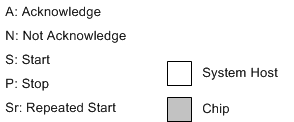SLUSDQ8D december 2019 – may 2023 TPS652353
PRODUCTION DATA
- 1 Features
- 2 Applications
- 3 Description
- 4 Revision History
- 5 Pin Configuration and Functions
- 6 Specifications
-
7 Detailed Description
- 7.1 Overview
- 7.2 Functional Block Diagram
- 7.3
Feature Description
- 7.3.1 Boost Converter
- 7.3.2 Linear Regulator and Current Limit
- 7.3.3 Boost Converter Current Limit
- 7.3.4 Charge Pump
- 7.3.5 Slew Rate Control
- 7.3.6 Short Circuit Protection, Hiccup and Overtemperature Protection
- 7.3.7 Tone Generation
- 7.3.8 Tone Detection
- 7.3.9 Audio Noise Rejection
- 7.3.10 Disable and Enable
- 7.3.11 Component Selection
- 7.4 Device Functional Modes
- 7.5 Programming
- 7.6 Register Maps
- 8 Application and Implementation
- 9 Device and Documentation Support
- 10Mechanical, Packaging, and Orderable Information
Package Options
Mechanical Data (Package|Pins)
- RUK|20
Thermal pad, mechanical data (Package|Pins)
- RUK|20
Orderable Information
7.5.2 TPS652353 I2C Update Sequence
The TPS652353 requires a start condition, a valid I2C address, a register address byte, and a data byte for a single update. After the receipt of each byte, TPS652353device acknowledges by pulling the SDA line low during the high period of a single clock pulse. TPS652353 performs an update on the falling edge of the LSB byte.
When the TPS652353 is disabled (EN pin tied to ground) the device cannot be updated via the I2C interface.
 Figure 7-10 I2C Write Data
Format
Figure 7-10 I2C Write Data
Format
 Figure 7-11 I2C Read Data Format
Figure 7-11 I2C Read Data Format